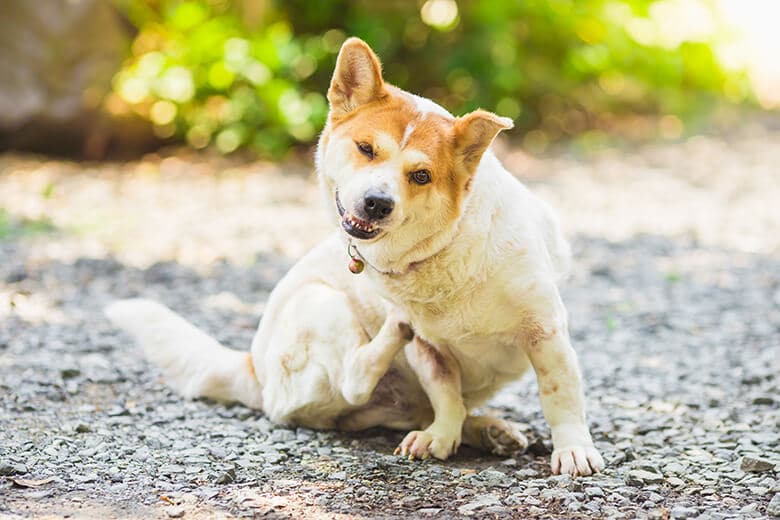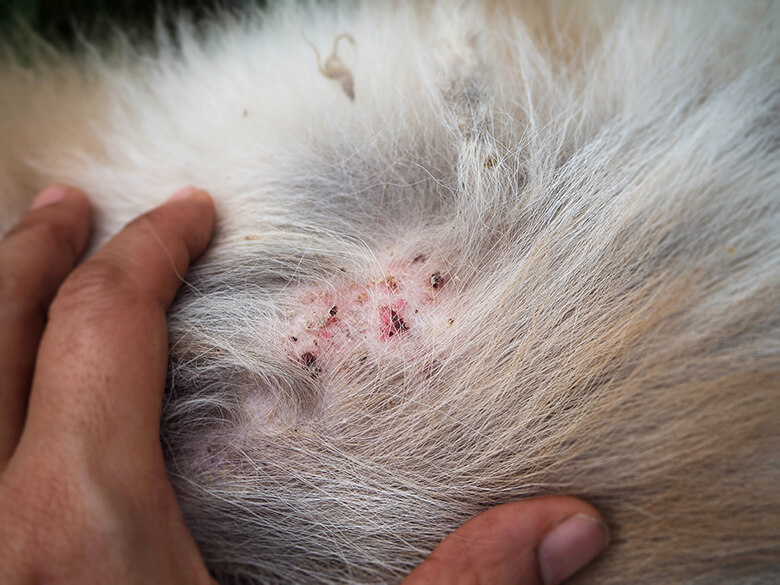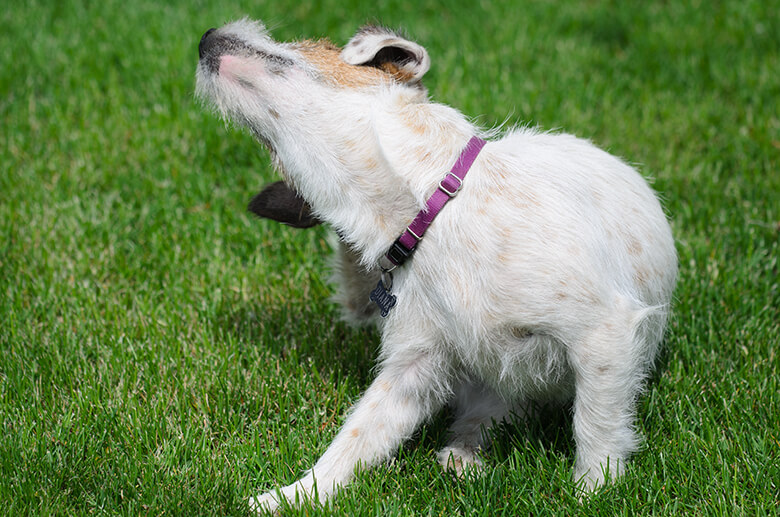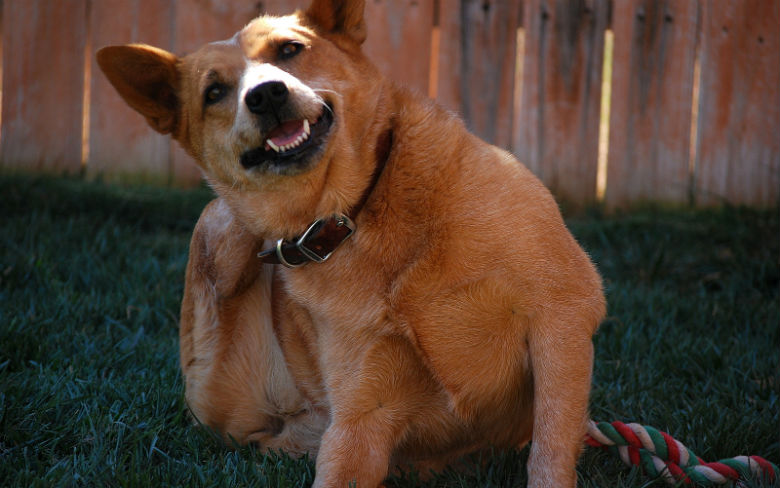Fleas are more than a nuisance. Over time, an untreated flea infestation can be deadly. That’s because fleas feed on a dog’s blood. They can consume 15 times their own weight in blood. Eventually, this leads to severe anemia, which can be fatal.
Fleas are nimble little creatures. They can jump 10,000 times in a row, moving from host to host and into your home. The flea bite causes itching, and in dogs that have allergies, the itching can be severe and lead to hair loss, inflammation, and skin infections.
Fleas prefer humid weather with temperatures above 65 degrees. Dogs (and cats) who spend time outdoors are most vulnerable.
Signs and Symptoms
There is the itching of course, but to narrow the cause down to fleas, look for:
Flea dirt: droppings that look like flecks of pepper in your dog’s coat. Pick one off, put it on a wet paper towel, and if after a few minutes the specks spread like a blood stain, your dog has fleas.
Flea eggs: tiny as a grain of salt, they look like eggs, but they’re very hard to see without a magnifying glass. You’ll find them in your dog’s bed or anywhere your dog hangs out.
Severe scratching: can also include licking or biting of skin, resulting in sores. These can be raw, oozing, or bloody.
Hair loss: patchy areas of hair loss
Hot spots and scabs: also called wet dermatitis, a hot spot causes your dog to literally scratch the hair off the skin, resulting in painful, raw, bleeding sores.
Tapeworms: dogs get tapeworms from fleas that are infected. They appear like grains of rice, and you’ll see them around your dog’s bottom and in the poop.
Pale gums: indicates severe anemia and requires immediate vet care.
Home Remedies for Fleas
Commercial flea preventatives and remedies often contain chemicals that may irritate your dog’s skin, eyes, and respiratory system. They can also be harmful to children. If you’d prefer not expose your kids (furry or otherwise) to these toxic chemicals, try one of these safer, natural options.
Natural Flea Collar
Buy a cotton or nylon collar. In a bowl, mix together:
1 teaspoon unflavored vodka
1 drop rosemary essential oil
1 drop thyme essential oil
Garlic oil from one capsule
Or
1 teaspoon unflavored vodka
1 drop eucalyptus essential oil
1 drop cedarwood essential oil
1 drop lemongrass essential oil
Lay the collar flat on a baking or cookie sheet and pour the mixture over the collar. Air-dry until it’s almost dry. Use as soon as it’s dry enough to be comfortable. Take the collar off when your dog is inside. Reapply the mixture once a week.
Flea Collar #2
Mix together:
1 teaspoon Witch Hazel
2 drops each: lavender essential oil, cedarwood essential oil, thyme essential oil, and melaleuca (tea tree) essential oil
1 tsp garlic oil
You can also replace the garlic oil with grapeseed oil or fractionated coconut oil.
Natural Flea Spray
You’ll need an empty spray bottle. Gather together:
1 organic lemon
2 sprigs of fresh rosemary
1 sprig of garden sage (Salvia officinalis)
1 sprig of lavender
1 quart of filtered water
Slice the lemon into thin rounds. Place the lemon, rosemary and sage in a large stainless steel or glass bowl. Add a quart of almost boiling water. Cover and let steep overnight. Strain the liquid into a spray bottle. Refrigerate. It will last 1 to 2 weeks.
Spray the dog’s coat, concentrating on the belly, legs, tail, and ears. Also, spray the areas where your dog sleeps and stays.
Natural Flea Spray #2
Gather together:
1 cup of white distilled vinegar
1 quart of water
2-3 drops of lavender oil
A large bowl
Large spray bottle
If your dog already has fleas, use this solution. Mix together the white distilled vinegar, water, and lavender oil in a bowl, and pour into the spray bottle. Spray directly onto your dog avoiding the eyes, ears, nose, and genitals. Let the spray dry on your dog. Spray twice a day until the fleas are gone. Also spray your dog’s bedding and your carpets at least twice per day until the fleas are no longer seen.
Apple Cider Vinegar
Mix together a 50/50 solution of apple cider vinegar and water. Put into a spray bottle and spray your dog’s coat.
You can also use an apple cider rinse to help repel fleas. In a bottle or jar with a tight cap, mix together:
Apple cider vinegar: ½ cup
Brewed green tea (cooled): ½ cup
Distilled water: 1 cup
After bathing, apply the rinse to your dog’s coat and skin and massage in. Rinse well and pat dry, and then allow to air dry.
Natural Flea Dip
Wash your dog with this solution, letting it remain on your dog for a few minutes before rinsing off. Use at least once a week.
You’ll need:
½ cup of freshly squeezed lemon
1 ½ to 2 cups of warm water
¼ cup of mild pet shampoo
An empty jar or bottle
Pour the lemon, water, and shampoo into the jar or bottle. Gentle shake or stir to combine.
Citronella Oil
This mixture has a very strong scent, and some dogs make not tolerate it. Test it first on a small area on your dog before using.
You’ll need:
1 gallon of hot water
20 drops of citronella oil
10 drops of tea tree oil
10 drops of lemongrass essential oil
5 drops of geranium oil
Spray bottle
Combine all the ingredients in a large bowl and pour into the spray bottle. After testing, spray your dog’s coat, avoiding the eyes, ears, nose, and genitals. Leave the citronella spray mixture on your dog until it dries. Repeat once per day until the fleas are gone. Make sure to spray your dog’s bedding and other areas in the home.





















